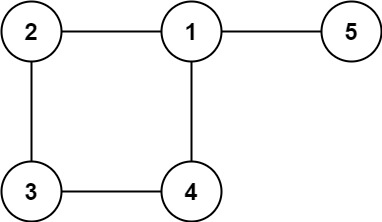LeetCode in Kotlin
684. Redundant Connection
Medium
In this problem, a tree is an undirected graph that is connected and has no cycles.
You are given a graph that started as a tree with n nodes labeled from 1 to n, with one additional edge added. The added edge has two different vertices chosen from 1 to n, and was not an edge that already existed. The graph is represented as an array edges of length n where edges[i] = [ai, bi] indicates that there is an edge between nodes ai and bi in the graph.
Return an edge that can be removed so that the resulting graph is a tree of n nodes. If there are multiple answers, return the answer that occurs last in the input.
Example 1:

Input: edges = [[1,2],[1,3],[2,3]]
Output: [2,3]
Example 2:

Input: edges = [[1,2],[2,3],[3,4],[1,4],[1,5]]
Output: [1,4]
Constraints:
n == edges.length3 <= n <= 1000edges[i].length == 21 <= ai < bi <= edges.lengthai != bi- There are no repeated edges.
- The given graph is connected.
Solution
class Solution {
private lateinit var par: IntArray
fun findRedundantConnection(edges: Array<IntArray>): IntArray {
val ans = IntArray(2)
val n = edges.size
par = IntArray(n + 1)
for (i in 0 until n) {
par[i] = i
}
for (edge in edges) {
val lx = find(edge[0])
val ly = find(edge[1])
if (lx != ly) {
par[lx] = ly
} else {
ans[0] = edge[0]
ans[1] = edge[1]
}
}
return ans
}
private fun find(x: Int): Int {
return if (par[x] == x) {
x
} else {
find(par[x])
}
}
}

